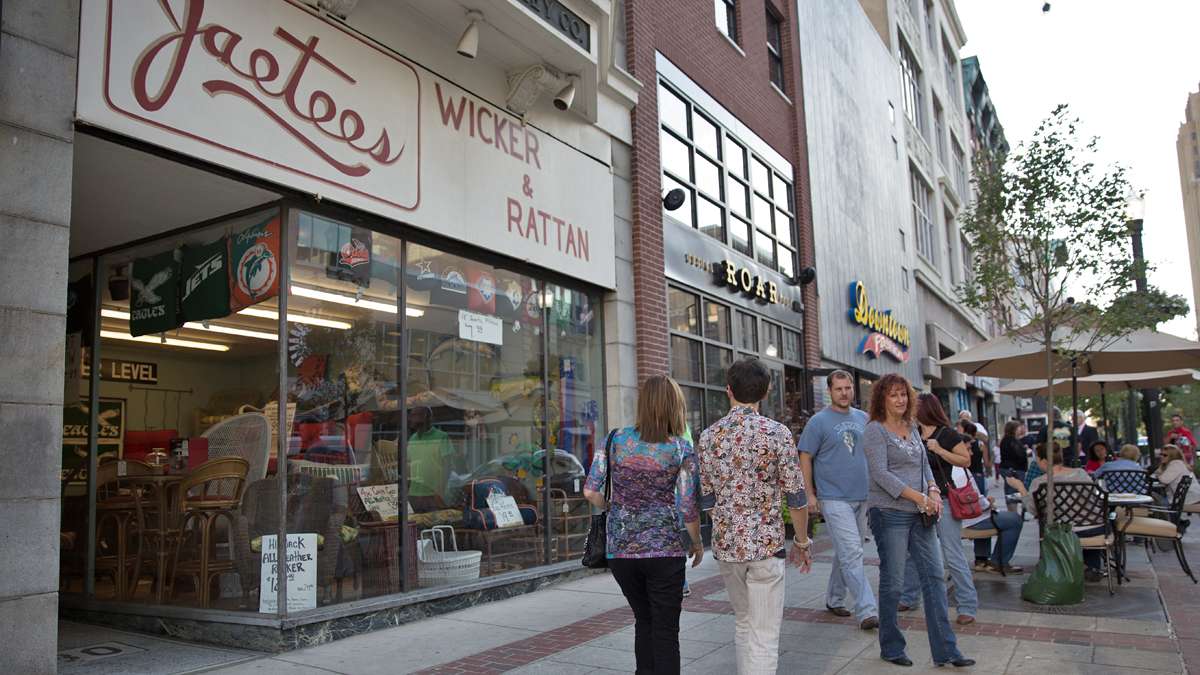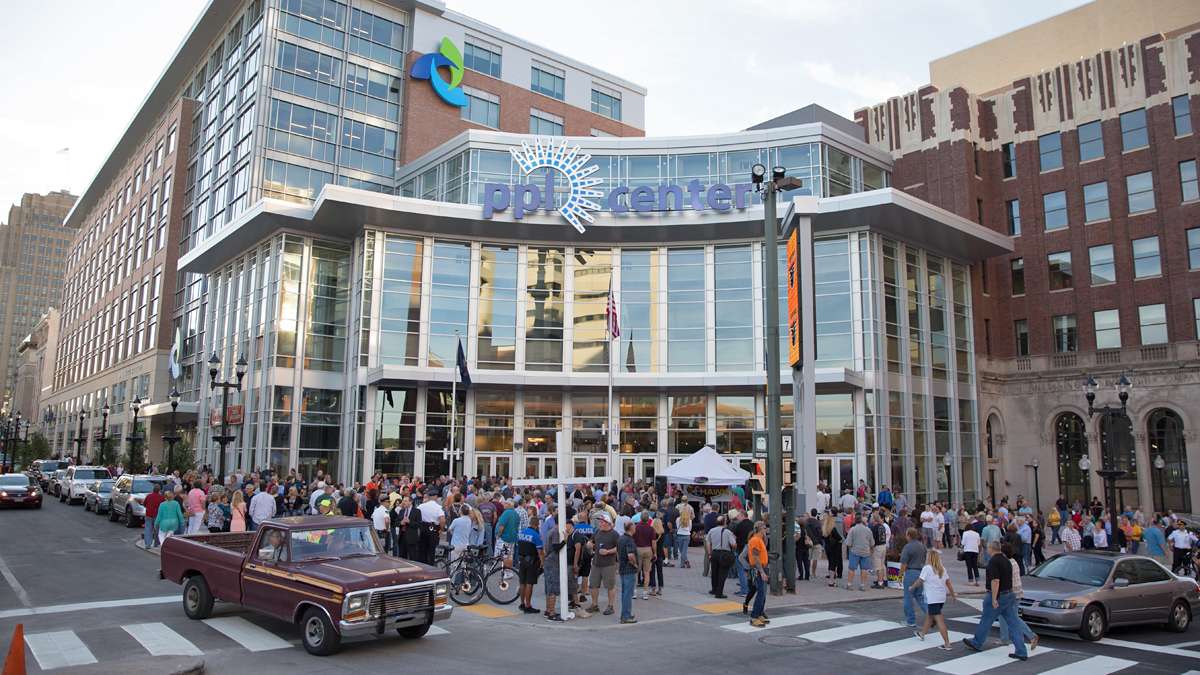Can Allentown score big with new hockey arena development?
Listen-

-

-

-

-

-

-

-

Visitors to Allentown wander through the city on the night of the hockey arena opening.(Lindsay Lazarski/WHYY)
-

-

Crowds gather outside of the PPL Center in downtown Allentown for opening night — a sold out Eagles concert. The arena is home to the Lehigh Valley Phantoms hockey team and is the heart of the city's Neighborhood Improvement Zone. (Lindsay Lazarski/WHYY)
Academics say publicly subsidized sports venues usually don’t live up to a city’s promises. But Allentown officials say its new hockey arena is different.
Allentown’s new arena has gotten a lot of attention lately, with many saying it could help revive the struggling city.
The $200 million arena, PPL Center, is the new home of the minor league hockey team the Lehigh Valley Phantoms. But the arena’s first event was an Eagles concert a few weeks ago. On opening night, thousands of people spilled onto the city’s sidewalks from restaurants and bars that didn’t exist a few months ago.
“I’ve never seen anything quite like this,” said Josh Tucker, the owner of JaeTee’s Wicker, a furniture store across the street from the arena. “It is the biggest happening in 30 years in downtown Allentown. No question about it.” Tucker went to the concert with a group of friends who, for years, couldn’t have imagined coming to Allentown for recreation.
Allentown is the third largest city in the state, and it used to be a retail hub, with big department stores like Hess’, Leh’s and Zollinger’s. But in the 1990s, those stores shut down as suburban malls drew business out of Allentown. Poverty increased downtown. During those years, Tucker turned his store into a storefront warehouse, selling mostly to other businesses online.
Now, Tucker is hoping all the new foot traffic will boost business. “You’ll probably have Mrs. Suburbia and her children coming for a hockey game and they’ll probably see the wicker store and walk in,” he said. “Will she buy? Probably not. But she’ll see what we have, and maybe in the future when she’s in need for that product, she will come in.”
Tucker’s wicker store and the arena are part of the city’s Neighborhood Improvement Zone (NIZ). That’s an area of Allentown where developers can use state and local tax dollars that would have gone to the government to construct, rehabilitate, and expand buildings. Advocates say the zone will bring in new businesses, provide jobs for locals, and entice people to come downtown.
Since the zone revolves around an arena, it raises longstanding questions about whether publicly subsidized sports venues are a good use of taxpayer money. But Allentown officials say this arena is different.
Part of a bigger strategy
One reason a sports stadium or arena might fail to boost local business is if it’s isolated. One example: the minor league baseball stadium Coca-Cola Park, which Allentown built six years ago on the outskirts of the city. It’s not downtown, and there’s nothing else around it. “Most of the time, people will leave the game, they’ll get in their car and they’ll just get on [US-22] and get out of town,” said Allentown Mayor Ed Pawlowski. “So it’s not really having any economic benefit for the city of Allentown.”
The new hockey arena is designed so that event-goers have to walk around Allentown, said Pawlowski. The doors open onto on a downtown street. “We have venues and events that are going to be right outside the arena,” Pawlowski said. “As you’re walking to your car, you’re going to pass one of these places and maybe you’ll stop at Tony Luke’s [Allentown location] and get a cheesesteak.”
The arena is also part of a larger tax incentive zone, the NIZ, that’s getting new restaurants and bars to move into the city. The city says this spinoff development will create more jobs and make the area around the venue a destination.
This is also an arena, not a single-sport stadium. Stadiums usually have a small number of events every year — rarely enough to boost the local economy. The arena will have close to 200 events, including concerts, rodeos, trade shows, circuses, Disney on Ice performances, indoor football, basketball, and of course, hockey games.
Lower-risk Financing
Even if nobody wants to go to these events and the NIZ falls flat, Pawlowski said this arena is less risky for the city than other publicly subsidized sports venues. “The city, the county, the state, is not on the line for any of the debt,” he said.
When cities build a sports venue, they’ll often be liable to pay for the construction debt if their plan doesn’t bring in enough tax revenue.
In Allentown, it will take 30 years to pay off the debt on the arena. If at any point there aren’t enough tax dollars to pay the debt, the city and state don’t have to pay the difference. If the Neighborhood Improvement Zone brings in more money than needed, those extra tax dollars go back to the government.
But the arena still comes at a price. Before the NIZ existed, businesses in the same geographical area paid more than $22 million dollars in state and local taxes that are now being used to fund the arena and other projects.
That money could instead be used to pay for state programs or services for Allentown residents, said Andrew Zimbalist, a professor of economics at Smith College. The state and city will still be giving up this revenue every year if the arena fails. “There isn’t even a pretense that this is a cost-free method of financing for the residents,” Zimbalist said.
Zimbalist added that residents only have so much money to spend on restaurants, bars, and concerts. “What’s happening is that entertainment dollars are moving from one area of the city to another,” he said. Allentown officials said they’re hoping the arena will bring new customers from the suburbs, Philadelphia, New Jersey, and New York.
Pushing out locals
Still, some worry the arena will exclude the people who live in Allentown.
On opening night, Ce-Ce Gerlach was one of several Allentown residents standing outside the arena, on the street, looking up at the bright lights.
Gerlach is a school board member in the city, and she lives two blocks away from the arena. Earlier in the evening, she watched visitors from Allentown’s wealthy suburbs flow through the arena’s doors. “You don’t see too many community folks going inside, because we can’t afford the tickets,” she said.
Tickets to the Eagles concert cost between $60 and $180 each. Other events like hockey games will be cheaper, about $20 apiece.
In Allentown, half of downtown residents live below the poverty line. The unemployment rate is nearly twice the state average.
Gerlach acknowledges that these residents need visitors to come, spend their money, and support jobs for locals. “All residents want jobs,” Gerlach said. “And regardless of how they feel about the arena and the NIZ, the idea that it’s going to bring job is something that everyone is for.”
According to the city, 67 percent of the 300 employees hired by the arena management company live in Allentown. The parking authority and a couple new restaurants have also hired mostly city residents. Other companies have yet to report their job numbers.
Even though the arena has created jobs, Gerlach is afraid it’ll push locals out of their homes. “Many of the people who live downtown are from New York. They’ve seen this happen in Brooklyn,” she said. “It’s not like it’s going to happen tomorrow, but five years down the road, will my apartment building still be there? No.”
Gerlach said that as part of the arena project, the city should come up with a concrete plan for affordable housing downtown.
She said she wants this arena to be different — to be a success. She just hopes the people who live in Allentown can get their fair share.
Learn more about Allentown’s Neighborhood Improvement Zone and how it works.
WHYY is your source for fact-based, in-depth journalism and information. As a nonprofit organization, we rely on financial support from readers like you. Please give today.


